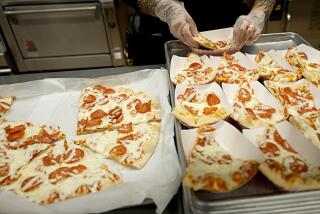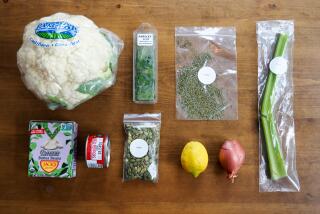Specific Rules for Packing a Safe Lunch
- Share via
The opening of school means that increasing numbers of lunches are soon to be packed in households around the Southland. It’s a good time to review the basic rules for packing safe meals--sensible sanitation, personal hygiene and sound food care. The U.S. Department of Agriculture Food Safety and Inspection Service has some specific suggestions for packing a safe lunch.
Begin by keeping utensils and countertops used in preparing lunches clean. Wash them thoroughly with soap and hot water. The same goes for your hands. Wear rubber gloves if you have any cuts or sores.
Use Tongs or Fork
Cook all food thoroughly. Remember to use tongs or a fork rather than your fingers to place meat, poultry or cheese in sandwiches.
If food is meant to be hot, keep it hot. If it’s meant to be cold, keep it cold. Bacteria thrive at temperatures between 60 and 125 degrees, so food should not be held in this temperature zone for more than two or three hours, including preparation time.
Lunch boxes, especially insulated ones, hold the cold items better than paper bags do and are easy to keep clean. If you use the familiar brown bags, use them only once. It’s possible for used bags to be contaminated with bacteria.
Vacuum bottles are a good way to keep foods hot or cold. Bring hot foods to a boil before placing in the vessels to ensure safety. Just remember to wash and rinse these bottles in boiling water after each use.
You also can keep food cold by packing one of the commercial frozen gel devices, a plastic bag with ice cubes or a can of cold beverage with the lunch. Some types of sandwiches freeze well, will thaw by noon and will keep the rest of the lunch cool.
Dry meats, such as beef jerky and pepperoni, and fully cooked meats, such as franks, corned beef, salami and bologna, are good choices for packing. However, almost any meat or poultry may be used if cooked and handled properly.
Fruits and Vegetables
Fruits and vegetables need only be well cleaned before they are included. Individually packaged dried fruits, such as raisins, make good additions.
Storing the lunch in as cool a place as possible is also important. Seldom is a refrigerator available, but teach your lunch carriers to keep their bags and boxes away from sunlight and radiators.
It doesn’t take much extra time or effort to pack good, safe lunches. Especially when the health of your loved ones is the reward.
More to Read
Eat your way across L.A.
Get our weekly Tasting Notes newsletter for reviews, news and more.
You may occasionally receive promotional content from the Los Angeles Times.










